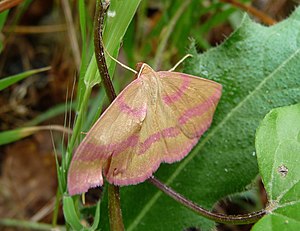Rhodostrophia
| Rhodostrophia | ||||||||||||
|---|---|---|---|---|---|---|---|---|---|---|---|---|

Red-rimmed gorse ( Rhodostrophia calabra ) |
||||||||||||
| Systematics | ||||||||||||
|
||||||||||||
| Scientific name | ||||||||||||
| Rhodostrophia | ||||||||||||
| Huebner , 1823 |
The genus Rhodostrophia is a species-rich genus of the butterfly family of Spanner (Geometridae). A total of over 76 species are included in this genus. Eight species are given for Europe. There are only two types in German-speaking countries.
features
They are rather small moths with a wingspan of a little over 20 millimeters to approximately 40 millimeters. There is usually a double areole in the wing veins . The vein that separates the two starts from the cell. The wires R2 to R4 are stalked. The R5 wire starts from the apex of the second areole. On the hind wing, the stalk of Rs and M1 is relatively short. The wires M3 and CuA1 are usually separated. The antennae of the male are quadripectinate. The proboscis is well developed, the palpi are short to medium in length.
In the male genital apparatus the uncus is usually very long and mostly diagnostic for the species. The gnathos is present, the shape of the valves is also often species-specific. The aedeagus is elongated and comparatively slender: it is slightly curved with characteristic features at the tip. The sternum A8 is bilobed at the rear end. In the natural position, the two lobes are bent down.
In the female genital apparatus, the ovipositor has no ventral processes. The ductus bursa is sclerotinated and enlarged at the posterior end. In contrast, the corpus bursae is only surrounded by a membrane. The signum consists of paired, elongated sclerites with longitudinal ribs.
The eggs are usually ribbed lengthways. The caterpillars are relatively long and slender. The doll has an elongated cremaster . It has four pairs of bristles, one pair is terminal, three pairs are on the edge.
Geographical distribution and habitat
The species of the genus Rhodostrophia occur from Europe to Taiwan . Most species of the genus live in West and Central Asia. Few species are also found in the temperate zones of the Palearctic . The species live in dry and moist habitats . However, they are predominantly heat-loving.
Phenology and way of life
The species of the genus are univoltin to plurivoltin , depending on the habitat. In many species, the caterpillars are still unknown and thus also the host plants. In species of which the life cycle is known to some extent, the caterpillars are mostly polyphagous and also different herbaceous plants , with some an emphasis on legumes (Fabaceae) can be observed. Where known, the caterpillar overwinters.
Systematics
The genus includes 72 species. Only the European species are listed here:
- Rhodostrophia badiaria (Freyer, 1841)
- Common broom-red ribbon spanner ( Rhodostrophia calabra (Petagna, 1786))
- Rhodostrophia cretacaria Rebel, 1916
- Rhodostrophia discopunctata (Blackbird, 1935)
- Rhodostrophia jacularia (Huebner, 1813)
- Rhodostrophia pudorata (Fabricius, 1794)
- Rhodostrophia tabidaria (Zeller, 1847)
- Rotbandspanner ( Rhodostrophia vibicaria (Clerck, 1759))
The type species of the genus is Phalaena calabra Petagna, 1786. Rhodostrophia is the type genus of the tribe Rhodostrophiini Prout, 1935.
swell
Individual evidence
- ^ Hausmann, p. 253
- ^ Robert Trusch and Axel Hausmann: A new species of the genus Rhodostrophia Huebner, 1823 from Iran (Geometridae: Sterrhinae). Nota Lepidopterologica, 30 (1): 7-16, Karlsruhe 2007 ISSN 0342-7536 .
- ↑ according to Lepiforum
literature
- Axel Hausmann: The Geometrid moths of Europe, 2nd Sterrhinae. In A. Hausmann (Ed.): The Geometrid Moths of Europe 2. Apollo Books, Stenstrup 2004, ISBN 87-88757-37-4
- Walter Forster , Theodor A. Wohlfahrt : The butterflies of Central Europe. Volume 5: Spanner. (Geometridae). Franckh'sche Verlagshandlung, Stuttgart 1981, ISBN 3-440-04951-5 .
- Günter Ebert (Hrsg.): The butterflies of Baden-Württemberg Volume 8, Nachtfalter VI (Spanner (Geometridae) 1st part), Ulmer Verlag Stuttgart 2001. ISBN 3-800-13497-7
Web links
- Lepiforum - Overview of the subfamilies of the Geometridae with a listing of the species
- Fauna Europaea
- The genus Rhodostrophia on the site "Lepidoptera and some other life forms" by Markku Savela
- Butterflies and Moths of the World - Generic Names an their Type Species - Natural History Museum London